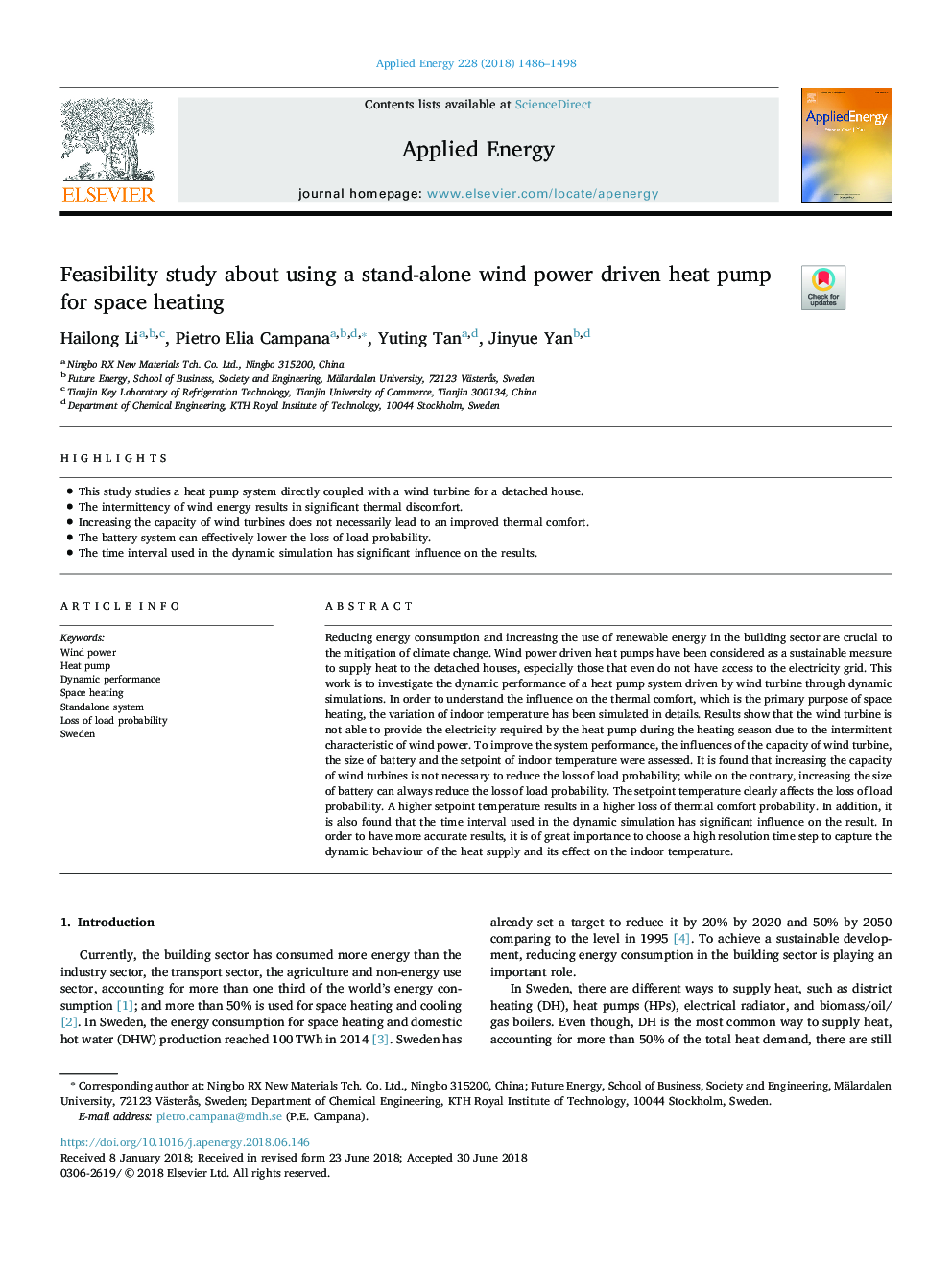| کد مقاله | کد نشریه | سال انتشار | مقاله انگلیسی | نسخه تمام متن |
|---|---|---|---|---|
| 6679848 | 1428063 | 2018 | 13 صفحه PDF | دانلود رایگان |
عنوان انگلیسی مقاله ISI
Feasibility study about using a stand-alone wind power driven heat pump for space heating
ترجمه فارسی عنوان
مطالعه امکان سنجی در مورد استفاده از پمپ حرارتی برقی مستقل باد برای گرم شدن فضای
دانلود مقاله + سفارش ترجمه
دانلود مقاله ISI انگلیسی
رایگان برای ایرانیان
کلمات کلیدی
قدرت باد، پمپ حرارتی، عملکرد دینامیک، گرمایش فضایی، سیستم مستقل، از دست دادن احتمال بار، سوئد،
ترجمه چکیده
کاهش مصرف انرژی و افزایش استفاده از انرژی های تجدید پذیر در بخش ساختمان برای کاهش تغییرات آب و هوایی ضروری است. پمپ های حرارتی بادی باد به عنوان یک معیار پایدار برای تامین گرما به خانه های جدا شده، به ویژه کسانی که حتی دسترسی به شبکه برق ندارند، مورد توجه قرار گرفته اند. این کار برای بررسی عملکرد دینامیکی یک سیستم پمپ گرما است که توسط توربین بادی بوسیله شبیه سازی دینامیکی هدایت می شود. به منظور درک تاثیر بر راحتی حرارتی، که هدف اصلی گرمایش فضایی است، تغییرات دما در محیط به طور دقیق شبیه سازی شده است. نتایج نشان می دهد که توربین بادی به دلیل ویژگی متناوب نیروی باد قادر به تامین برق مورد نیاز پمپ گرما در فصل گرم نیست. برای بهبود عملکرد سیستم، تأثیر ظرفیت توربین بادی، اندازه باتری و مقادیر دمای داخلی مورد بررسی قرار گرفت. مشخص شده است که افزایش ظرفیت توربین های بادی برای کاهش ضرر بار احتمالا ضروری نیست؛ در حالی که برعکس، افزایش اندازه باتری همیشه می تواند از دست دادن احتمال بار کاهش یابد. درجه حرارت تعیین شده به وضوح از دست دادن احتمال بار می شود. یک درجه حرارت بالاتر از درجه حرارت بالاتر باعث کاهش احتمال راحتی حرارتی می شود. علاوه بر این، همچنین مشخص شده است که فاصله زمانی استفاده شده در شبیه سازی دینامیکی تأثیر قابل توجهی بر نتیجه دارد. برای به دست آوردن نتایج دقیق، اهمیت بسیار زیادی برای انتخاب یک گام زمانی با وضوح بالا برای رعایت رفتار دینامیکی گرما و تأثیر آن بر دمای داخلی است.
موضوعات مرتبط
مهندسی و علوم پایه
مهندسی انرژی
مهندسی انرژی و فناوری های برق
چکیده انگلیسی
Reducing energy consumption and increasing the use of renewable energy in the building sector are crucial to the mitigation of climate change. Wind power driven heat pumps have been considered as a sustainable measure to supply heat to the detached houses, especially those that even do not have access to the electricity grid. This work is to investigate the dynamic performance of a heat pump system driven by wind turbine through dynamic simulations. In order to understand the influence on the thermal comfort, which is the primary purpose of space heating, the variation of indoor temperature has been simulated in details. Results show that the wind turbine is not able to provide the electricity required by the heat pump during the heating season due to the intermittent characteristic of wind power. To improve the system performance, the influences of the capacity of wind turbine, the size of battery and the setpoint of indoor temperature were assessed. It is found that increasing the capacity of wind turbines is not necessary to reduce the loss of load probability; while on the contrary, increasing the size of battery can always reduce the loss of load probability. The setpoint temperature clearly affects the loss of load probability. A higher setpoint temperature results in a higher loss of thermal comfort probability. In addition, it is also found that the time interval used in the dynamic simulation has significant influence on the result. In order to have more accurate results, it is of great importance to choose a high resolution time step to capture the dynamic behaviour of the heat supply and its effect on the indoor temperature.
ناشر
Database: Elsevier - ScienceDirect (ساینس دایرکت)
Journal: Applied Energy - Volume 228, 15 October 2018, Pages 1486-1498
Journal: Applied Energy - Volume 228, 15 October 2018, Pages 1486-1498
نویسندگان
Hailong Li, Pietro Elia Campana, Yuting Tan, Jinyue Yan,
